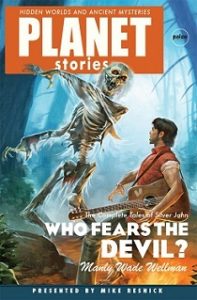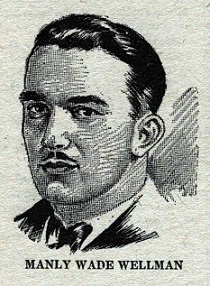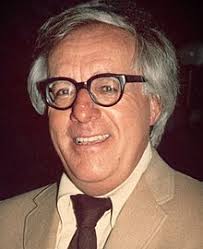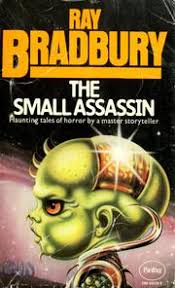
© Polaris Productions / Hawk Films / Warner Bros.
The world is in a dystopian condition at the moment. It’s being ravaged by a deadly virus that’s especially rampant in countries run by authoritarian, anti-science, right-wing clowns like Donald Trump and Jair Bolsonaro (and not forgetting the UK’s own right-wing pipsqueak Boris Johnson). Meanwhile, propelled by manmade climate change, temperatures continue their remorseless rise. Much of Australia was in flames at the start of this year while the recent record-breaking heat in the Arctic Circle indicates that ecological catastrophe could be bearing down on us rather sooner than we’d expected.
I feel glad that I’m a big fan of dystopian fiction. I’ve read so many books set in dystopian futures over the decades that now, when I actually find myself living in the dystopia of 2020, I don’t feel in the least bit surprised. None of this came as a nasty shock for me.
I’ve also been thinking about dystopian fiction recently because I’m currently halfway through Yoko Ogawa’s The Memory Police (1994), which as its title suggests takes place in an authoritarian society where memory itself is policed. Gradually, everyday items like flowers, perfume and photographs are deleted physically, from people’s everyday existences, and mentally, from their memories. As the world loses its precious details and becomes drabber and greyer, the body enforcing these deletions, the Memory Police of the title, becomes ever-more oppressive. I don’t know if Ogawa will manage to keep this premise interesting for the novel’s full 274 pages, but so far I’ve been impressed.
I’ve thought about it too because of the death last month of French author Jean Raspail, known for his apocalyptic novel The Camp of the Saints (1973). I haven’t read Camp and don’t intend to, because from all accounts it’s the nightmare fantasy of an ultra-right-wing, ultra-Catholic, ultra-privileged white French male and is a bucket of racist slime. Let me quote from its synopsis on Wikipedia. Camp depicts France being swamped by a tidal wave of immigrants from India, who have names like ‘the turd eater’, have ‘monstrously deformed’ children, indulge in public fornication, are ‘filthy’ and ‘brutish’ and ‘flout laws, do not produce and murder French citizens’. They’re aided and abetted in their takeover of France by lefty aid workers, journalists, politicians, ‘charities, rock stars and major churches’. Needless to say, the book is much admired by the likes of Steve Bannon and Marine Le Pen. I only hope that, before he croaked, Raspail took a look at the rankings of the world’s strongest economies. Because he would find that India, source of his racistly sub-human bogeymen in Camp, is now in fifth place, which is two places above his precious France. Maybe one day an Indian author will write a reply to Camp, in which an affluent India is invaded by hordes of starving, third-world Frenchmen.
Anyway, all this has set me thinking. If I had to name my favourite dystopian novels, what would they be?

© Penguin Books
I’d better start by defining my terms. By dystopian fiction I mean a story set in a society that’s gone seriously off the rails, either because of hellish political oppression of some sort, or because of a natural or man-made cataclysm that’s turned life into a scramble for survival. It has to be set at least a little way into the future, not in the present. And there’s the issue of location. The horribleness described in a proper dystopian story, for me, has to be widespread, if not global. Therefore, books like William Golding’s The Lord of the Flies (1954) or J.G. Ballard’s High Rise (1975), where the societal breakdown takes place respectively on an island and in a tower block, don’t qualify because they’re too localised in scale.
I will also disqualify novels where the setting for the story is pretty grim, but that’s all the dystopian element is – a setting, a backdrop against which the plot takes place. We gets glimpses of bad stuff in the background, but we’re more interested in the narrative and in the psychology of the characters. So for that reason I will exclude William Gibson’s Neuromancer (1984) and Philip K. Dick’s Do Androids Dream of Electric Sheep? (1968). In a proper dystopian story, the world is in an awful state and that state has to be at the forefront, so vivid that it becomes an important character itself in the story, if not the most important character.
And I will leave out novels where, yes, present-day society has met its nemesis and collapsed, presumably bloodily and destructively, but where the narratives take place so far in the future that they feel like fantasy or fairy stories. The settings are so distant and fantastical that there’s little or no link with our own world, and the reader isn’t disturbed by the thought of what happened to civilisation between now and then. So that means H.G. Wells’ The Time Machine (1895) and Brian Aldiss’s Hothouse (1962) are both out.
I’ve seen lists of dystopian novels that include ones set in alternative universes, like Philip K. Dick’s The Man in the High Castle (1962) or Kazuo Ishiguro’s Never Let Me Go (2005). But I’m excluding them too because, for me, a properly effective dystopian novel has to take place in a universe that’s recognisably our own one. The thought, “This could happen to me or to my children, grandchildren or descendants” has to be prominent in the reader’s mind.
Finally, I’ve left out Kim Stanley Robinson’s New York 2140 (2017) because, although it’s set in a future New York that’s largely underwater thanks to global warming, and although it impressed me with its scale and ambition, I found it a bit too hopeful to qualify. To hit the required nerve, dystopian fiction has to be depressing and pessimistic. There’s no room on my list for nice dystopian fiction. Sorry, Kim.
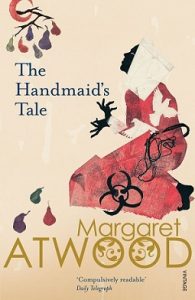
© Vintage Books
Right. I’ve just disqualified nine or ten commonly cited classics of dystopian fiction. Is there anything left to go on my list? Well, actually, there is. I’d have liked to present an alliteration-friendly number of titles, such as a ‘top ten’ or a ‘dystopian dozen’ or a ‘first fifteen’, but I’ve ended up with sixteen. These are:
Greybeard (1964) by Brian Aldiss.
The Handmaid’s Tale (1985) by Margaret Atwood.
Oryx and Crake (2003) by Margaret Atwood.
The Drowned World by (1962) J.G. Ballard.
Fahrenheit 451 (1953) by Ray Bradbury.
A Clockwork Orange (1962) by Anthony Burgess.
The Death of Grass (1956) by John Christopher.
Make Room! Make Room! (1966) by Harry Harrison.
Brave New World (1932) by Aldous Huxley.
Memoirs of a Survivor (1974) by Doris Lessing
The Iron Heel (1907) by Jack London.
I am Legend (1954) by Richard Matheson.
The Road (2006) by Cormac McCarthy.
1984 (1949) by George Orwell.
Fugue for a Darkening Island (1972) by Christopher Priest.
Day of the Triffids by (1951) John Wyndham.
A few books that are regarded as classics of dystopian writing aren’t on the list because, simply, I haven’t read them yet. They include P.D. James’s Children of Men (1992), about a near-future world where mass sterility means that no children are being born and society is destabilising as the population ages. A similarly-themed book is on the list, though, Brian Aldiss’s Greybeard, which takes the scenario further and imagines a future England where nobody is under 50, nature is quickly wiping out traces of human civilisation and the oldsters are finding it increasingly hard to distinguish reality from senility-induced fantasy. Actually, the sci-fi writer Adam Roberts, who wrote the introduction to my copy of Greybeard, reckons it’s a better novel than the more acclaimed Children of Men.

© Signet Books
Some of my inclusions are predictable – Orwell, Huxley, Burgess, McCarthy. Meanwhile, Margaret Atwood is the only person on the list with two entries, The Handmaid’s Tale and Oryx and Crake, so Madge is officially the Queen of Dystopian Literature as far as I’m concerned. I was tempted to include a couple of J.G. Ballard’s other works like The Drought (1964) and The Crystal World (1966), but I opted for The Drowned World because it’s the first and most famous of his surreal, psychological and hallucinogenic novels set during or after a global catastrophe. And irrespective of their individual merits, The Drought and The Crystal World do feel like variations on a Ballardian theme. Whereas with Atwood, the nastily patriarchal and reactionary society envisioned in The Handmaid’s Tale and the ecological disaster zone described in Oryx and Crake are two very different creations.
Many people would argue that Richard Matheson’s I am Legend is actually a horror novel, a vampire one, but the apocalyptic plague Matheson describes is given a scientific rationale; so it could happen, just about. It was also a massive influence on George A. Romero’s zombie movies, which in turn gave rise to the zombie-apocalypse trope that’s now a major sub-genre of dystopian fiction, TV and cinema.
Nowadays it’s fashionable to knock Day of the Triffids because of the middle-class cosiness of its characters. Their personalities manage to remain decent, upstanding and Radio 4-ish even after 99% of the population have been blinded and giant, mobile, flesh-eating plants have invaded the streets. And even some of Wyndham’s admirers might argue that The Chrysalids (1955) and The Kraken Wakes (1953), both of which feature dystopias of their own, are better books. But I think Day of the Triffids deserves its place in the list because of its impact on popular culture. The word ‘triffid’ has entered the English language. I’ve heard it used to describe everything from a noxious-looking weed growing in somebody’s garden to the state of Helena Bonham Carter’s hair.
On the other hand, I’ve picked John Christopher’s The Death of Grass and Christopher Priest’s Fugue for a Darkening Island because they offer an antidote to Wyndham’s cosiness. Both books have characters who start out as respectable middle-class English types whose personalities undergo a breakdown as violent and frightening as the disasters – a plague that destroys cereal crops in Death, a refugee crisis caused by a limited nuclear war in Fugue – rocking the societies around them.
One novel I feel really deserves its place on the list is Harry Harrison’s disturbing meditation on the dangers of human overpopulation, Make Room! Make Room! It just annoys me when people compare Make Room with its 1973 film version, Soylent Green, and pontificate that the book isn’t as good because it doesn’t have the film’s two big gimmicks. These are a euthanasia clinic, to which the character Sol (Edward G. Robinson in the film) goes when he decides that he can’t handle any more of the world’s ghastliness, and the film’s twist ending when it’s revealed that the mysterious foodstuff Soylent Green, a major component of the future human diet, is… people! (You have to shout it in Charlton Heston’s voice.)

© Penguin Books
However, as Harrison pointed out, and unbeknownst to the filmmakers, euthanasia clinics and suicide machines are a bit of a cliché in science fiction. (Not so long ago, I read Robert W. Chambers’ The King in Yellow, published back in 1895, and it had something called a ‘government lethal chamber’ in it.) And Harrison had researched Make Room meticulously to make its apocalypse seem as realistic as possible, so he knew that the idea of humanity relying on industrialised cannibalism to survive wasn’t feasible. Human beings don’t fatten up quickly and require a lot of feeding and looking after, so as a form of livestock to meet the world’s dietary needs, they’re economically a bad idea. And as this study shows, they’re not even that rich in calories.
On the other hand, one novel that nearly didn’t make my list was Doris Lessing’s Memoirs of a Survivor because it feels rather dated now. The problem is that the feral kids and gangs of violent youths that populate the novel seem a bit, well, hippy-ish. Sorry, Doris, but when I try to imagine a Mad Max-style dystopia I don’t normally see crowds of hippies running at me with chainsaws. Of course, Memoirs was written in the early 1970s when memories of the Summer of Love, Woodstock, flower power, etc., were still fresh. It’s a pity Lessing didn’t write it a couple of years later, after the much more dystopia-friendly punk rockers had appeared. Still, I like the novel for its psychological depth, with the narrator escaping from the claustrophobic confines of her apartment by concentrating on a wall until she’s able to ‘pass through’ it into an imaginary realm. And considering that dystopian novels are frequently dominated by male characters, it’s good to see one where female characters are at the forefront.
Incidentally, my brother, who works in the building industry, once told me that while he was attending a health-and-safety seminar about the dangers of asbestos, the speaker mentioned Ray Bradbury’s Fahrenheit 451. He said that in 1953, as a publicity gimmick, the publisher Ballantine produced 200 numbered and signed copies of Fahrenheit 451 that were bound in asbestos. The joke was that in a future society where are books had to be burned, these 200 copies of the novel couldn’t be burned. Obviously, at the time, people were unaware of the links between asbestos and lung cancer.
Now that sounds like a truly dystopian book – one that tells a story about a totalitarian future society whilst having the power to induce a dystopian-style breakdown inside the reader’s body.
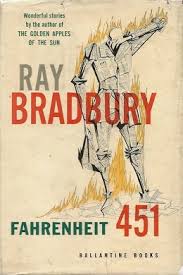
© Ballantine Books
This is an updated version of an entry that first appeared on this blog in July 2014.



